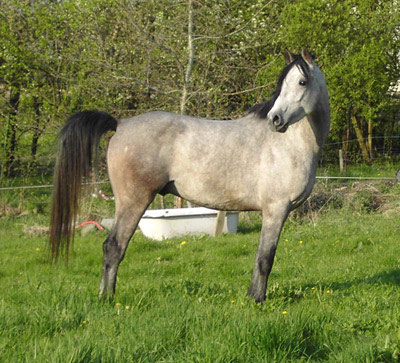- Shagya Arabian
Infobox Horse
name= Shagya Arabian
image_caption=Shagya Arabian
features =
altname=
country=Hungary, sourteastern Europe
group1=
std1= |The Shagya Arabian was developed in the
Austro-Hungarian Empire during the 19th century at theBábolna ,Mezőhegyes , Radautz, Piber, and Topolcianky studs. Today it is most often seen in theCzech Republic ,Austria ,Romania , the formerYugoslavia n countries,Poland ,Germany , andHungary , but has been exported to other nations and is bred around the world. Apurebred Shagya Arabian today has bloodlines can be traced in all lines to the stud books of Radautz, Babolna, and Topolcianky. The breed is considered by some to be a subspecies ofArabian horse , but due to the presence of a small amount of non-Arabian breeding is considered anAnglo-Arabian or a partbred Arabian in some places.Origin
One of the major founding sires was Shagya, a gray Arabian [http://www.shagya-arabian-horses-asav.org/about.html "citing" "The Other Arabian Horse" "Arabian Horse World," April, 1983.] scanned article at [http://www.shagya-arabian-horses-asav.org/article2.pdf] ] (or, some say part-Arabian) stallion with some ancestors of the Kehilan and Siglavy strains. Born in
Syria in 1810, he was taller than the average Arabian of the time, standing 15.2-1/2 hands high (62 1/2 inches at thewithers ). He was mostly used forcrossbreeding at Babolna, bred fewasil Arabian mares, and thus has no pure Arabian descendants today. http://www.shagya-araber.info/shagya-line.htm "Pure Bred Shagya-Araber Society International"] Many of the Arabian stallions standing at Babolna and other studs werecrossbred with mares who already possessed a great deal of Arabian influence due to the long Turkish occupation of Eastern Europe. SomeThoroughbred s andLipizzan s were also used. In all cases, meticulouspedigree records were kept.Originally, these predominantly, but not
Asil ("pure") Arabian horses were referred to by thegeneric term "Araberrasse" (Arab "race" or breed, indicating predominantly Arabian ancestry) but was changed after the second World War into Shagya by the Hippologist Dr. Gramazky because he was worried that the non-purebred descendants of Shagya would be mixed up with the Purebred Arabian horses that were also produced in Hungary. At time, the name was chosen because Shagya was in virtually every Pedigree as an ancestor, though many other Arabian bloodlines are also a part of the Shagya breed.Bloodlines
While Shagyas are not considered "pure" or
asil Arabians, they have aclosed stud book and have special status within the World Arabian Horse Association (WAHO). In 1978, WAHO stated that Shagya Arabians that have been bred pure after the system of Babolna and Topolcianky may be termed "pure bred Shagya Arabians", and the Shagya breeders' organisation is under WAHO patronage as associate members, allowed to use the WAHO emblem. However, WAHO also was clear that Purebred" in this case means that the horses have been bred pure among themselves and are not to be confused with the term "purebred Arabian." Some aficionados note that the meticulous recordkeeping of the Hungarian studs actually has produced horses with longer and more complete pedigrees than some horses accepted as "purebred" Arabians by mainstream registries. However, in spite of this argument, Shagyas remain a distinct bloodline group and are generally not accepted as "pure-blooded Arabians." [ [http://www.waho.org/Definition.html WAHO, Purebred Arabian horse definition, 2007] ]Traits
The Shagya Arabian exhibits traits similar to the
asil or purebred Arabian horse, with high carried tail, sound bone and excellent endurance. However, due to the small influx of non-Arabian breeding and the breeding goals of the Hungarian studs, Shagyas tend to be taller, less refined, and bigger-boned than purebred Arabians; the modern Shagya is usually at least 15 hands tall and commonly 16 hands, whereas the breed standard for the Arabian ranges from 14.1 to 15.1 hands, with some individuals over and under that height.Uses
This breed is recognized as a riding horse, and is also driven in
harness . It was a hardycavalry horse and is now popular insport horse disciplines such asdressage ,eventing andendurance riding . [ [http://www.ansi.okstate.edu/breeds/horses/shagya/index.htm "Shagya"] . "Oklahoma State University". Referenced May 21, 2008.] The 2006 FEI Endurance World Champion was a Shagya gelding bred at Babolna. [ [http://www.ceer-fc.com/dossiers/dossiers.php?id_dossier=257 "Le Shagya, champion du monde!"] . "CEER de France Comte". Referenced May 21, 2008.]ee also
*
Arabian horse References
External links
*http://www.Shagyas.com - Shagya breed information portal
*http://www.shagya-araber.info/indexe.htm - International Shagya Society
*http://www.shagya-arabian-horses-asav.org/index.html - North American Shagya Arabian Verband
*http://www.shagya.net - North American Shagya Arabian Society
*http://www.horsequest.com/bredshow/shagya/shagya.htm Shagya Horse Breed Spotlight
Wikimedia Foundation. 2010.
